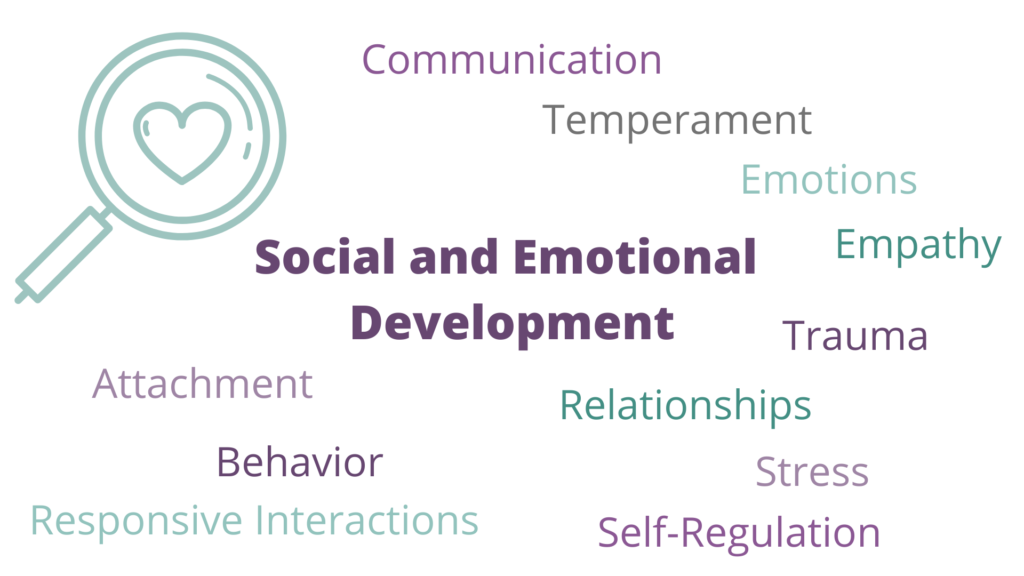Early social and emotional development includes the ability for young children to “form close and secure adult and peer relationships; experience, regulate, and express emotions in socially and culturally appropriate ways; and explore the environment and learn — all in the context of family, community, and culture” (Yates et al., 2008, p. 2). This describes the way infants and toddlers understand and communicate their emotions to build healthy relationships with those closest to them.
When you think about social and emotional development, all of the words above may come to mind. Each word is a critical component of social and emotional development. In early intervention, all practitioners play a key role in supporting the emotional well-being of every young child and their family.

Why and What You Can Do
“Social and emotional experiences with primary caregivers as well as interactions with other children and adults early in life set the stage for future academic and personal outcomes, and undergird other areas of development” (Darling-Churchill & Lippman, 2016, p. 2). You have a unique opportunity to nurture the connection between the caregiver and child and promote successful outcomes for each child you serve.
Here are eleven easy strategies you can implement to support social and emotional development:
1. Boost the parents’ confidence. This is a hard time for many parents. Parents may feel responsible for their child’s developmental delay. Building their confidence empowers them to feel competent. When someone feels good, it makes them happy. This helps promote positive parent-child interactions.
2. Support the child’s self-esteem. Children tend to avoid difficult tasks. After all, nobody likes failing. Boosting a child’s self-esteem gives him/her confidence to explore and try new things.
3. You can never give too much information. Explain what you are doing and why you are doing it. This helps parents understand the reasoning behind the intervention strategies you suggest or model.” Give parents plenty of opportunities to ask questions.
4. Focus on increasing positive parent-child interactions. Many children may resist demands placed on them. A positive parent-child interaction removes the feeling of a demand and makes the interaction playful and fun. It enhances the bond between the caregiver and child.
5. Read cues and intervene before a child is in his/her red zone. There are four stress responses a child may experience: Green zone, red zone, blue zone, or combo zone. Click here to read the checklist that identifies different behaviors associated with each zone. Positive emotions are associated with the green zone and negative emotions are associated with the other stress responses. Children are more likely to come back and stay in the green zone when parents are attuned to their moods and feelings. Becoming a detective for your child’s stress cues can be a great tool to improve attunement.
6. Model the behaviors you wish to see. We can help parents learn to model behaviors they want to see in their children as they grow into adults. Children learn how to manage big feelings in large part by watching their adults manage big feelings.
7. Explain the importance of comfort. Comfort is a big part of secure attachment. So often parents get mixed messages about comfort from society – sometimes it seems as if comfort is the same as creating a weak child. We can bust that myth by sharing the information we know about the role of comfort in early brain development.
8. Provide structure and routine. Routines are the safe walls around a child’s day. There is no RIGHT kind of routine but whatever it is, the more predictable for the child, the better. Routines that are repetitive for a child help them make sense of the world. They will always have another chance to practice the things they struggle with most.
9. Use positive behavior supports. A positive and proactive approach to supporting behaviors helps reduce parental stress and increase positive behaviors in children as they aim to please their parents. These strategies decrease reactivity and should be individualized for each child and situation.
10. Label emotions. Language is a major learning tool for children and during the young toddler and preschool years, we learn and use language as a way of making sense of the world. Putting words to feelings helps children learn that feelings are generally transient and aren’t a permanent state of being. This is something we should be regularly talking about with our parents.
11. Increase parent responsiveness. Parent responsiveness nurtures a safe, secure attachment allowing a child to explore and thrive in their environment as the child becomes more resilient and independent. Wonder with the parents about what their child may be feeling or thinking so they can respond in an intentional and positive way.
What challenges or barriers do you face as an early interventionist supporting social and emotional development?
What other strategies would you add to support each child’s social and emotional development?
Additional Resources:
DEC Child Social-Emotional Competence Checklist
Supporting Social and Emotional Development: What ALL Early Interventionists Can Do Handout
References
Darling-Churchill, & Lippman, L. (2016). Early childhood social and emotional development: Advancing the field of measurement. Journal of Applied Developmental Psychology, 45, 1–7. https://doi.org/10.1016/j.appdev.2016.02.002
Yates, T., Ostrosky, M., Cheatham, G., Fettig, A., Shaffer, L., & Santos, R. (2008). Research synthesis on screening and assessing social–emotional competence. Retrieved from Center on the Social Emotional Foundations for Early Learning http://csefel.vanderbilt.edu/documents/rs_screening_assessment.pdf


